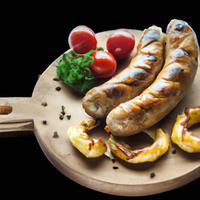
1 serving (50 grams) contains 150 calories, 6.0 grams of protein, 13.5 grams of fat, and 1.0 grams of carbohydrates.

Log this food in SnapCalorie

Nutrition Information
Calories |
709.8 | ||
|---|---|---|---|
% Daily Value* |
|||
| Total Fat | 63.9 g | 81% | |
| Saturated Fat | 23.7 g | 118% | |
| Polyunsaturated Fat | 0 g | ||
| Cholesterol | 165.6 mg | 55% | |
| Sodium | 2129.3 mg | 92% | |
| Total Carbohydrates | 4.7 g | 1% | |
| Dietary Fiber | 0 g | 0% | |
| Sugars | 2.4 g | ||
| protein | 28.4 g | 56% | |
| Vitamin D | 47.3 mcg | 236% | |
| Calcium | 47.3 mg | 3% | |
| Iron | 2.8 mg | 15% | |
| Potassium | 473.2 mg | 10% | |
* Percent Daily Values are based on a 2,000 calorie diet. Your daily values may be higher or lower depending on your calorie needs.
Food Attributes
Source of Calories
About Two saugages
Two sausages typically consist of ground meat, seasoning, and natural or synthetic casing. Commonly made from pork, beef, or chicken, these versatile proteins are staples in a variety of cuisines, including German, Italian, and British fare. Ingredients like garlic, paprika, fennel, or herbs give sausages their distinct flavors, while regional styles influence preparation methods, from smoked to fresh or cured. Nutritionally, sausages can be high in protein, iron, and B vitamins, making them a robust option for energy. However, traditional sausages are often high in saturated fats, sodium, and preservatives, which can pose challenges for heart health or those watching their salt intake. Choosing leaner options or varieties made with whole ingredients can offer a healthier alternative. Pairing sausages with nutrient-dense sides, such as leafy greens or whole grains, helps balance the meal while showcasing their savory appeal in diverse dishes.



